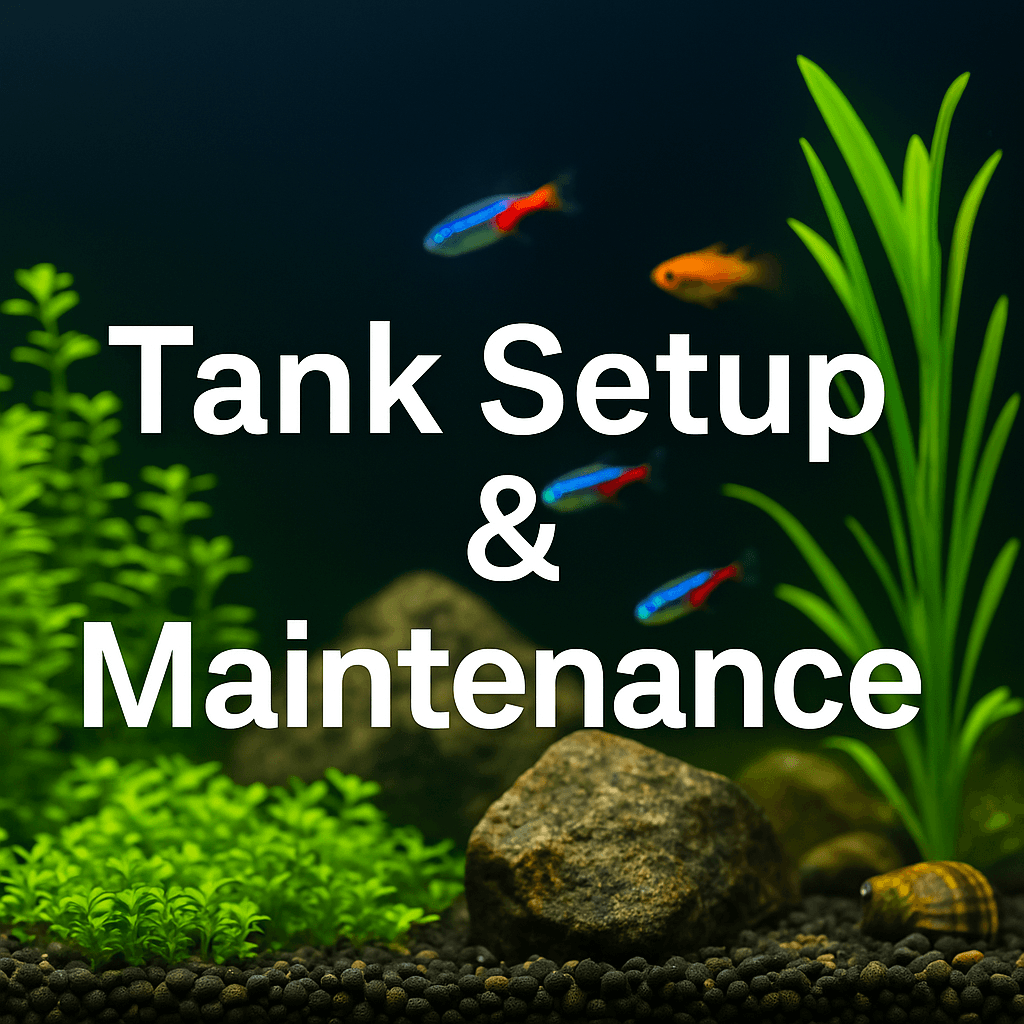
Tank Setup & Maintenance Guide: Build and Maintain a Healthy Aquarium
Setting up and maintaining a freshwater aquarium may look complicated at first — filters, substrates, lighting, cycling, stocking, cleaning — but once you understand the process, it’s one of the most rewarding hobbies you’ll ever take on. This comprehensive tank setup and maintenance guide walks you through each step in plain English, from choosing the right tank to long-term care. Whether you’re a beginner starting your first 10-gallon or an intermediate hobbyist upgrading to a planted community tank, this 2,000-word walkthrough gives you everything you need.
🧱 Choosing the Right Aquarium Size and Shape
Bigger tanks are often easier to maintain than small ones. Why? Because more water means more stability. If your heater malfunctions or ammonia spikes, a 5-gallon will crash much faster than a 29-gallon. Here’s what to consider:
- 10–20 gallons: Good for bettas, shrimp, and small communities
- 29–40 gallons: Ideal for community tanks with schooling fish
- 55+ gallons: Great for planted setups or larger fish like cichlids or gouramis
- Long vs tall: Long tanks provide more surface area for oxygen exchange
🏗️ Essential Equipment for Your Aquarium
- Filter: Sponge, hang-on-back (HOB), or canister depending on tank size
- Heater: Necessary for tropical fish (set around 76–78°F)
- Lighting: Basic LEDs for low-tech tanks; stronger lights for planted tanks
- Thermometer: Always know your tank temp at a glance
- Water conditioner: Neutralizes chlorine and chloramines from tap water
- Test kit: For monitoring ammonia, nitrites, nitrates, pH, and more
- Gravel vacuum: Crucial for water changes and removing debris
- Timer: For automatic lighting schedule (8–10 hrs/day)
🌱 Substrate & Decor: Setting the Foundation
The substrate is more than just gravel — it impacts plant growth, fish health, and water chemistry. Choose your base based on what type of tank you’re building:
- Inert gravel: Budget-friendly and easy to clean
- Sand: Great for bottom-dwellers like corydoras and loaches
- Plant substrates: Like Fluval Stratum or Eco-Complete for planted tanks
- Aquascaping: Use rocks, driftwood, and caves — rinse everything before adding
🔁 The Nitrogen Cycle: Your Aquarium’s Life Support
Cycling your aquarium before adding fish is the most important part of setup — and the most often skipped. The nitrogen cycle establishes colonies of beneficial bacteria that convert toxic ammonia (from fish waste) into nitrite, then into less toxic nitrate. This process takes 4–6 weeks on average. During this time, you should:
- Use pure ammonia or fish food to start the cycle (fishless cycling)
- Test water daily for ammonia, nitrite, and nitrate
- Only add fish when ammonia and nitrite are 0
- Use bottled bacteria like Seachem Stability or FritzZyme to speed up cycling
🐠 Stocking Your Tank Safely
Once your tank is cycled, it’s time to add livestock. But resist the urge to fully stock all at once. Add slowly — a few fish at a time — and monitor parameters. Here’s a basic stock list by tank size:
| Tank Size | Example Stock |
|---|---|
| 10 gallons | Betta + nerite snail + cherry shrimp |
| 20 gallons | 6 neon tetras + 4 corydoras + 1 honey gourami |
| 29 gallons | 8 harlequin rasboras + 6 kuhli loaches + 1 bristlenose pleco |
| 55 gallons | 12 cardinal tetras + 8 panda corys + 2 pearl gouramis + 1 rubber lip pleco |
🧽 Maintenance: How to Keep It All Running
Once your tank is established, proper maintenance ensures it stays balanced, beautiful, and healthy. Here’s your long-term care schedule:
Weekly
- Test water for ammonia, nitrite, nitrate
- Change 20–30% of the water using dechlorinated water
- Vacuum gravel or substrate (one area at a time)
- Wipe glass, remove algae from decor
Monthly
- Rinse filter sponge/media in tank water
- Inspect filter impeller and tubing for clogs
- Trim aquarium plants, remove dying leaves
- Replace carbon or chemical filtration if needed
Quarterly
- Deep clean hardscape (wood, rocks)
- Replace expired test kits and review gear
- Inspect heater accuracy with separate thermometer
🌿 Special Considerations for Planted Tanks
If you’re going for a planted tank, you’ll want to consider lighting spectrum, fertilization, and CO2 injection. Here’s what you need to get started:
- Use root tabs under crypts, swords, and other root feeders
- Liquid fertilizers like Easy Green help stem plants thrive
- Low-tech setups (Java fern, anubias, hornwort) don’t need CO2
- Maintain a 6.5–7.4 pH range for most plant species
🧠 Common Beginner Mistakes to Avoid
- Adding fish before cycling the tank
- Overfeeding (causes ammonia spikes and algae)
- Skipping water changes because the tank “looks clean”
- Cleaning filter media in tap water
- Using glass cleaner or soap near the aquarium
📋 Final Thoughts and Action Plan
Your aquarium is a living system. Once set up properly and maintained regularly, it becomes a self-sustaining ecosystem that gives back beauty and tranquility. Start small if needed, learn as you go, and don’t be afraid to course-correct. Use this guide as your playbook, and your tank will reward you tenfold.
🐟 What to Read Next
🎥 Subscribe to DBC Aquatics on YouTube for tank builds, product reviews, maintenance walkthroughs, and more weekly content for freshwater fishkeepers.